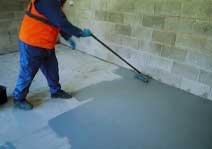Concrete Paint
Advantages of Concrete Paint
Concrete Paint Vs Concrete Stains
Concrete stains and concrete paints are both beautiful options for coloring your concrete and which one you choose comes down to the concrete surface and personal preference.
Types of Concrete Paint
Free Quote

Concrete Porch and Patio Paint
This paint is a latex-based paint that is designed to resist scuffing, fading, UV damage, and peeling. This paint offers gloss and low-luster options that can be used on interior concrete.

Waterproofing Masonry Paint
Like the name says, these paints are designed for use on brick and other masonry but have been found in basements and garages alike. This type of paint is great for resisting moisture, mildew, and dirt.

Garage and Floor Paint
This option is intended specifically for areas that have vehicle traffic like your garages and carports. This specific formula will resist grease, motor oil, and gasoline stains. With this paint option, you don’t have to be concerned about peeling from hot tires.
Call For a Quote:
844-482-8330
Pro Tips for Concrete Painting
It is best to apply concrete paint to fresh concrete that is free of not only dirt and dust but any type of coatings or sealers. The concrete should be free of these contaminants to ensure the proper bond of the paint to the concrete surface. For concrete to be painted it is also recommended that there be a slight texture to the surface. This can be achieved by acid etching or mechanical abrasion like with light grinding.
Follow the manufacturer’s recommendations for your concrete paint. Some paints may require the surface to be primed while some products are self-priming. Following these recommendations is important to ensure the paint will adhere properly. Other recommendations that are common is the temperature during application as most recommend it be above 50 degrees.
Finally, for the paint to adhere properly the concrete needs to be clean, dry, and free from any moisture. You can test for moisture by duct-taping plastic to an area of the surface and leaving it for 24 hours. If condensation is present then the surface is too damp for concrete paint and additional drying time is needed.

How to Paint Your Concrete
Painting your concrete can be a project that you either hire a contractor for or try to tackle yourself. Whichever route you choose, the application is the same and it’s great to have an understanding of the process.
Step 1: Patch any blemishes in the concrete with a concrete filler. While minor blemishes can be covered with paint there are those that will need this filler to guarantee a smooth and beautiful finish. After filling any holes, scratches, or gouges in the concrete allow the filler to dry and follow up by sanding it to a smooth surface.
Step 2: Clean the concrete surface with a TSP solution and warm water removing any grease and oils that could potentially discolor the paint job. Work this solution with a metal bristled brush to get a nice clean surface. This solution can cause a slight bubbling of the surface. Allow this bubbling for 20 minutes and finish by rinsing the solution with a hose.
Step 3: Allow the concrete surface to dry completely once the solution has been thoroughly rinsed. Allow the surface to dry for 2 days before painting. When you run your hand across the dry surface of the concrete it should feel similar to 120-grit sandpaper.
Step 4: Time to paint! Start by painting the perimeter of the area carefully covering the corners and edges. Work your way into the interior of the area making sure to start on the far side of the room so that you end at a doorway or other stepping-off point. This first coat of paint will need to dry for at least 16 hours.
Step 5: Use a putty knife to scrape away any imperfections on the surface such as lumps and bumps. Sandpaper can be used in other areas that the paint didn’t adhere to the surface. Sweep the area to prepare the surface for the next coat.
Step 6: Apply the second and final coat of paint. With this coat, the roller will be pressed more firmly to ensure that paint can penetrate into the imperfections from the prior coat. This coat of paint should be allowed to dry for at least 5 days before the project is considered complete especially in high traffic areas.
Choosing A Contractor

